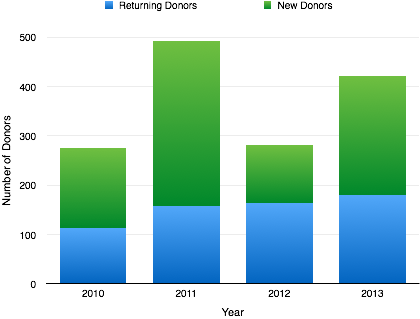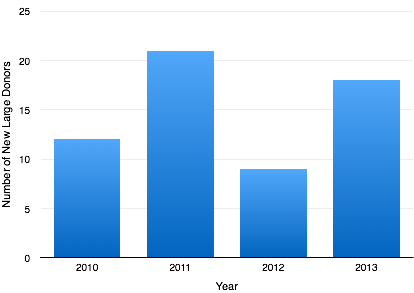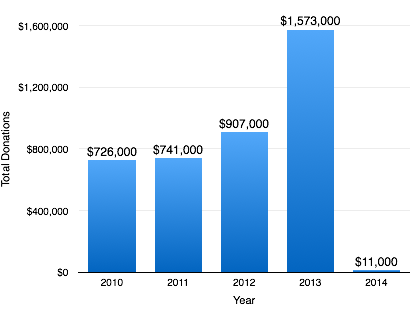Update 04/16/2014: At a donor’s request I have replaced the Total Donations per Year chart with one that shows which proportion of the donations were from new and returning donors. Some tweaks were also made to our donation database since the publication of this post, so I have updated the post to reflect these changes.
This is the 5th part of my personal and qualitative self-review of MIRI in 2013, in which I review MIRI’s 2013 fundraising activities.
For this post, “fundraising” includes donations and grants, but not other sources of revenue. ((I didn’t include other sources of revenue in this analysis because they don’t seem likely to play a significant role in our ongoing funding strategy in the forseeable future. For example, revenue from ebook sales is marginal, and we don’t plan to sell tickets to a new conference.))
Summary
- Our funding in 2013 grew by about 75% compared to 2012, though comparing to past years is problematic because MIRI is now a very different organization than it was in 2012 and earlier.
- We began to apply for grants in late 2013. We haven’t received money from any of these grantmakers yet, but several of our grant applications are pending.
- MIRI’s ability to spend money on its highest-value work is much greater than it was one year ago, and we plan to fundraise heavily to meet our 2014 fundraising goal of $1.7 million.
Numbers for 2013
We typically run two major fundraisers per year, and our winter fundraiser occurs during December and January. Often, some donations for each winter fundraiser don’t arrive until February. Hence, it’s most natural to summarize our fundraising success in “2013” by looking at the numbers from March 2013 to March 2014, rather than from January 2013 to January 2014. ((For this reason, the numbers reported in this post won’t match those in our 990s, which are anchored to calendar years. Also, the donation numbers in this post are approximate, not exact.)) So, from 03/01/2013 through 02/31/2014, our fundraising income consisted of:
- $525,000 from Jed McCaleb in XRP. ((This was the straightforward valuation of the XRP at the time of donation. Obviously, XRP is a volatile cryptocurrency, so it’s difficult to make a more accurate but principled valuation. However, XRP’s value rose sharply shortly after Jed’s donation, and as of 03/27/2014 it was still trading higher than at the time of donation. As of 03/27/2014 we’ve brought in ~$227,000 through the sale of ~25% of our XRP holdings. So in the end, it’s quite plausible we’ll eventually reap $525,000 or more from the XRP donation.))
- $250,000 from Peter Thiel.
- $100,000 from Jaan Tallinn.
- $690,000 from other individual donations, plus corporate matching.
- $89,000 of in-kind donations from Investling.
- $5,000 via Give for Free methods, mostly via the MIRI affinity card. (Sign up if you haven’t already!)
- $0 in grants. (Not including Google Grants.)
Comparison to past years
It’s difficult to meaningfully compare MIRI’s 2013 fundraising income to MIRI’s fundraising income in past years, because MIRI was so different in 2013 compared to previous years. In particular:
- From 2006-2012, we ran the Singularity Summit, which brought in revenue chiefly via ticket sales rather than donation. Some supporters bought Summit tickets rather than donating, or donated less than they would have had they not also bought a Summit ticket.
- During 2012, CFAR was still being “incubated” within MIRI, and so many expenses and donations were CFAR-related in a way that is difficult to disentangle.
- By 2013, we had sold the Summit, CFAR had become a separate organization with fully separate finances, and some donors who had previously been funding MIRI because of its rationality work switched (as planned) to funding CFAR instead.
But for the sake of completeness, let’s attempt the comparison anyway. ((The numbers in this section may not match past estimates, because we spent a lot of time filling in gaps in our donor database immediately before writing this post.))
Below is a chart of MIRI’s semi-recent historical fundraising, based on the records in our donor database. For reasons explained above, the numbers reported for each year are for a March to March period rather than for the calendar year. (In-kind donations are not included in this chart.)
Total Donations per Year
Another important data set concerns donor retention and new donor acquisition. This is a noisier process. Below is a chart showing the acquisition of new donors who gave for the first time in a given year, and the retention of donors who gave again in a giving year having already given at least once in a previous year. ((Again, using a March to March period rather than calendar year.))
Donor Acquisition and Retention per Year
Finally, here is a chart showing trends in the acquisition of “new large donors” who gave $5,000 for the first time in a given year, and less than $5,000 total previously. ((When considering who qualifies as a “new large donor,” I’m including money secured by the donor via corporate matching.))
New Large Donors per Year
Recent experiments and lessons learned
Recently, we asked (nearly) every donor who gave more than $3,000 in 2013 about the source of their initial contact with MIRI, their reasons for donating in 2013, and their preferred methods for staying in contact with MIRI. Of the approximately 35 respondents, nearly all seemed to be giving (in part) because they believe MIRI’s mission is highly important, and about half also mentioned excitement about the new focus on technical research and the results that focus has produced. Twenty-one of them came into contact with MIRI via Eliezer’s posts on Overcoming Bias or Less Wrong. Four came into contact with MIRI via HPMoR. The rest came through other sources.
In general, it has remained very difficult for MIRI to acquire new donors from populations that have not been previously exposed at length to effective altruism, applied rationality, existential risk, or AGI risk ideas and communities. As such, we will continue to prioritize the acquisition of new donors from within those circles and, as a longer-term fundraising strategy, we will (in the typical case) continue to direct new contacts toward those circles rather than straining to solicit donations from them immediately.
We began to apply for grants in late 2013. ((Again, not including Google Grants.)) We haven’t received money from any of these grantmakers yet, but several of our grant applications are pending.
Projected future needs
I think of Friendly AI research as MIRI’s core mission and our comparative advantage. I also think FAI research is MIRI’s highest-value work, for many reasons. Happily, MIRI’s ability to spend money on its highest-value work is much greater than it was one year ago. This is because:
- We now have three full-time Friendly AI researchers who are making FAI progress, publishing results, presenting at conferences, etc.
- We have several medium-term hiring prospects for full-time FAI research or FAI open problems exposition, if we have the funding to afford them.
- Our capacity to run workshops has increased dramatically. There are ~25 past MIRI workshop participants who performed well and who are interested to come to future workshops, and ~40 applicants we’ve deemed “promising” and might want to invite to future workshops. Moreover, building on our experience in 2013, we are able to start planning a broader variety of workshops, some in collaboration with major universities and other research institutes.
- Several more open problems in Friendly AI have been described in writing during the past year (see here), allowing other researchers to understand what we are working on.
In order to seize these growing opportunities to make FAI research progress and grow the FAI research community, we aim to raise $1.7 million in 2014. (That is, from March 2014 to March 2015.)
This is a “stretch” goal: there is a substantial probability we will fail to meet it. To meet this goal, we’ll need to make a stronger fundraising push than we have in past years. In particular, a greater fraction of my time will be devoted to fundraising than in past years.
One month into this new fundraising year, we have a long way to go:
Total Donations per Year Including 2014
If you are excited by our recent progress, and you’d like to see our Friendly AI research program continue to grow, please consider signing up for a monthly donation. If you’d like to make a large gift, please contact me at luke@intelligence.org directly.



